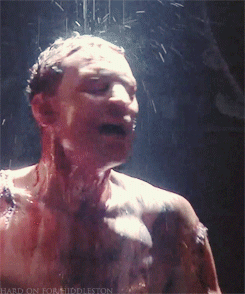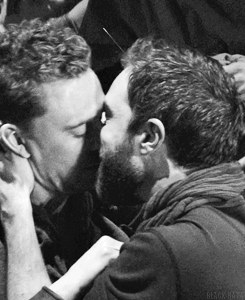Any interpretation of Shakespeare's canon will inevitably be, at least in some small way, unique. And with plays that have been in circulation as long as Shakespeare's have, interpretations will evolve and transform in relation to the circumstances of their staging; staging choices that would seem natural to an Elizabethan audience will change utterly for a 21st century production, and sociopolitical phenomena at the time of the performance will influence the symbology on the stage. The choices made by directors and actors speak both to their personal opinions about the play and to the nature of the society contextualizing the production.
One of the most recent large-scale productions of Coriolanus had its run in London, headed by director Josie Rourke and the Donmar Warehouse. The play starred Tom Hiddleston in the titular role, with an equally strong cast to back up his fantastic performance. The production, which aired a filmed live performance in cinemas around the world, does an incredible job of melding the world of the play with the political and aesthetic context of modern London, and makes a number of choices that feel simultaneously congruent with the source material and the world outside the theater.
A good example of this melding of influences is the dynamic between Coriolanus and Aufidius, particularly the scene depicting Coriolanus' arrival at Aufidius' home and the ensuing formation of an alliance. Even to the play's original audience, the homoerotic undertones (arguably overtones) between the two characters would have been hard to miss; their conversations are littered with innuendo and passionate declarations of a hybrid of love and hate. Their relationship is integral to the story, and Shakespeare, apart from a few wry nods to sexuality, treats their feelings for one another with earnest attention.
Rourke's production embraces this textual dynamic and runs with it, emphasizing the two men's simultaneous loathing and admiration of one another with impassioned delivery and overlong stares across the stage. Two moments typify the production's treatment of the relationship, and both are markedly physical; the first is a long moment of eroticized asphyxiation during a battle early in the play, and the second is a kiss in the middle of Aufidius' monologue accepting Coriolanus as an ally.
It's unlikely that earlier productions of Coriolanus would have added such a blatant physical dimension to this already homoerotic relationship, particularly one where the interactions have clear sexual connotations. However, nothing in the text precludes the possibility of physicality between the two characters, even the kind of sensual intimacy evident in their kiss; this production simply happens to have been directed in a cultural moment where the exploration of a queered dynamic is not just acceptable, but topical.
Much of the enduring magic of Shakespeare's body of work comes in the plays' ability to morph to suit the social atmosphere in which they are performed. The text is malleable; Coriolanus and Aufidius can exist both in ancient Rome and in the 21st century, and the latter can permit them a little more freedom to outdo Aufidius' memories of his bedchamber.


Great post. I wonder how this modern production would present the roles of Volumnia and Virgilia, especially as it relates to, arguably, their representations of the extremes of femininity (Volumnia with a number of masculine traits and Virgilia as hyper-feminine). Your point regarding the contrast between the modern depictions of Coriolanus and Aufidius' intimacy and Shakespeare's depiction makes me wonder whether or not Shakespeare's own sexuality had anything to do with the potential malleability of these moments in the play. Since, as we discussed in class, hinting at homosexual desires is perfectly acceptable in Elizabethan England so long as nothing of the sort actually takes place, does Shakespeare intend for the homoerotic desires between Coriolanus and Aufidius to be an interesting turn and ultimately laughed off, or does he forsee a social climate in which such homoerotic impulses allow for a serious look at the dynamics of these sorts of desires, possibly due to something personal at stake for him with regards to homosexuality? What does everyone else think?
ReplyDelete